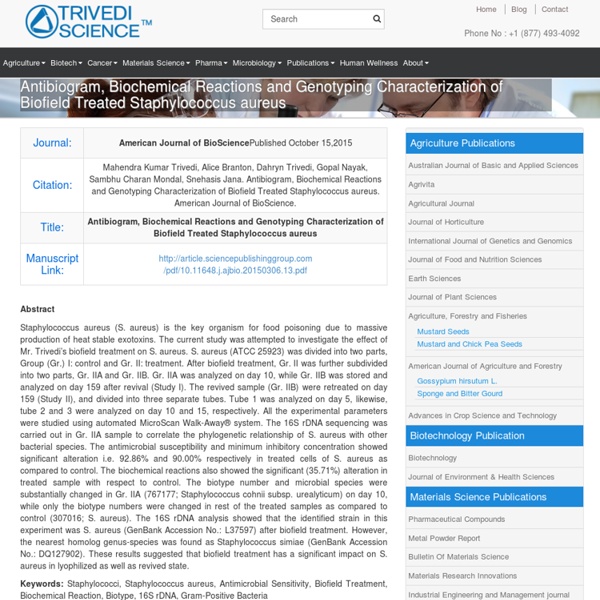



Biotyping of Enteropathogenic MDR Escherichia coli Isolates Description Study background: Multidrug resistant Escherichia coli (MDR E. coli) has become a major health concern, and failure of treatment leads to huge health burden. Aim of the present study was to determine the impact of Mr. Research on Escherichia Coli Biochemical Characteristics Bioeld as an energy medicine has been included in complementary and alternative medicine (CAM) therapies, and very commonly practiced in US by professional healthcare representative [11]. CAM therapies are very helpful to improve the human wellbeing and health without having any side eects. Investigation of Biofield Treatment on Antimicrobial Susceptibility, Biochemical Reaction Pattern and Biotyping of Enteropathogenic Multidrug-Resistant Escherichia coli Isolates - Trivedi Science Abstract Study background: Multidrug resistant Escherichia coli (MDR E. coli) has become a major health concern, and failure of treatment leads to huge health burden. Aim of the present study was to determine the impact of Mr. Trivedi’s biofield treatment on E. coli. Methods: Four MDR clinical lab isolates (LSs) of E. coli (LS 8, LS 9, LS 10, and LS 11) were taken and divided into two groups i.e. control and biofield treated. Control and treated samples were identified with respect to its antimicrobial sensitivity assay, biochemical study and biotype number using MicroScan Walk-Away® system.
Analysis of Multidrug Resistant S.Maltophilia Abstract Stenotrophomonas maltophilia ( S. maltophilia ) is a Gram-negative bacillus, an opportunistic pathogen, particularly among nosocomial infections. Multi-drug resistant strains are associated with very high rate of morbidity and mortality in severely immunocompromised patients. Present study was designed to evaluate the effect of biofield treatment against multidrug resistant S. maltophilia . Clinical sample of S. maltophilia was collected and divided into two groups i.e. control and biofield treated which were analyzed after 10 days with respect to control. The following parameters viz. susceptibility pattern, minimum inhibitory concentration (MIC), biochemical studies and biotype number of both control and treated samples were measured by MicroScan Walk-Away® system.
Potential Impact of Biofield on HIV Viral Load Test Abstract Viral load quantification is the amount of particular viral DNA or RNA in a blood samples. It is one of the surrogate biomarker of AIDS. High viral load indicates that the immune system is failed to fight against viruses. The aim of this study was to evaluate the impact of biofield treatment on HIV-1 and HCMV in terms of viral loads as surrogate marker. Experimental results of Escherichia Coli Antibiotic Sensitivity Assay Study background: Multidrug resistant Escherichia coli (MDR E. coli) has become a major health concern, and failure of treatment leads to huge health burden. Aim of the present study was to determine the impact of Mr. Trivedi’s biofield treatment on E. coli. Methods: Four MDR clinical lab isolates (LSs) of E. coli (LS 8, LS 9, LS 10, and LS 11) were taken and divided into two groups i.e. control and biofield treated.
Human Energy Impact on Thermal Properties of DHBP Citation: Trivedi MK, Tallapragada RM, Branton A, Trivedi D, Nayak G, et al. (2015) Physical, Thermal and Spectral Properties of Bioeld Energy Treated 2,4-Dihydroxybenzophenone. Clin Pharmacol Biopharm 4: 145. doi:10.4172/2167-065X.1000145 Page 8 of 8 Volume 4 • Issue 4 • 1000145 Characterization of Physical, Spectral and Thermal Properties of Biofield Treated 1,2,4-Triazole - Trivedi Science Abstract Triazoles are an important class of compounds used as core molecule for the synthesis of many pharmaceutical drugs. The objective of the present research was to investigate the influence of biofield treatment on physical, spectral and thermal properties of 1,2,4-triazole. The study was performed in two groups, control and treatment. The control group remained as untreated, and biofield treatment was given to treatment group. The control and treated 1,2,4-triazole were characterized by X-ray diffraction (XRD), Differential Scanning Calorimetry (DSC), Thermo Gravimetric analysis (TGA), Surface area analyzer, and Fourier transform infrared (FT-IR) spectroscopy.
Antimicrobial Sensitivity of Staphylococcus Saprophyticus Abstract Staphylococcus saprophyticus (S. saprophyticus) is a frequent cause of urinary tract infection in the young women. The current study was designed to analyze the effect of biofield energy treatment on S. saprophyticus for evaluation of its antibiogram profile, biochemical reactions pattern and biotyping characteristics. Two sets of ATCC samples were taken in this experiment and denoted as A and B. Sample A was revived and divided into two parts Group (Gr.I) (control) and Gr.II (revived); likewise, sample B was labeled as Gr.III (lyophilized). Gr.
Multidrug Resistant Isolates of Pseudomonas Aeruginosa Abstract In recent years, prevalence of multidrug resistance (MDR) in Pseudomonas aeruginosa (P. aeruginosa) has been noticed with high morbidity and mortality. Aim of the present study was to determine the impact of Mr.
Thermal Properties of DHBP after the Human Energy Treatment Description Study background: 2,4-Dihydroxybenzophenone (DHBP) is an organic compound used for the synthesis of pharmaceutical agents. The objective of this study was to investigate the influence of biofield energy treatment on the physical, thermal and spectral properties of DHBP. The study was performed in two groups (control and treated). The control group remained as untreated, and the treated group received Mr.
TGA Analysis of Biofield Treated 2,4-Dihydroxybenzophenone Study background: 2,4-Dihydroxybenzophenone (DHBP) is an organic compound used for the synthesis of pharmaceutical agents. The objective of this study was to investigate the influence of biofield energy treatment on the physical, thermal and spectral properties of DHBP. The study was performed in two groups (control and treated).